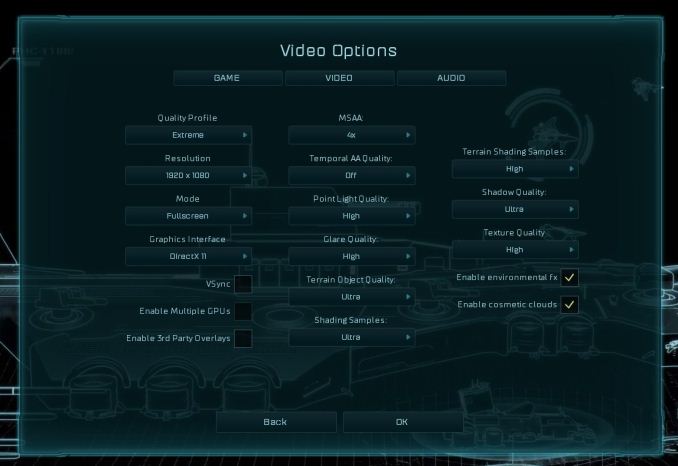Retesting AMD Ryzen Threadripper’s Game Mode: Halving Cores for More Performance
by Ian Cutress on August 17, 2017 12:01 PM ESTAshes of the Singularity Escalation
Seen as the holy child of DirectX12, Ashes of the Singularity (AoTS, or just Ashes) has been the first title to actively go explore as many of DirectX12s features as it possibly can. Stardock, the developer behind the Nitrous engine which powers the game, has ensured that the real-time strategy title takes advantage of multiple cores and multiple graphics cards, in as many configurations as possible.
As a real-time strategy title, Ashes is all about responsiveness during both wide open shots but also concentrated battles. With DirectX12 at the helm, the ability to implement more draw calls per second allows the engine to work with substantial unit depth and effects that other RTS titles had to rely on combined draw calls to achieve, making some combined unit structures ultimately very rigid.
Stardock clearly understand the importance of an in-game benchmark, ensuring that such a tool was available and capable from day one, especially with all the additional DX12 features used and being able to characterize how they affected the title for the developer was important. The in-game benchmark performs a four minute fixed seed battle environment with a variety of shots, and outputs a vast amount of data to analyze.
For our benchmark, we run a fixed v2.11 version of the game due to some peculiarities of the splash screen added after the merger with the standalone Escalation expansion, and have an automated tool to call the benchmark on the command line. (Prior to v2.11, the benchmark also supported 8K/16K testing, however v2.11 has odd behavior which nukes this.)
At both 1920x1080 and 4K resolutions, we run the same settings. Ashes has dropdown options for MSAA, Light Quality, Object Quality, Shading Samples, Shadow Quality, Textures, and separate options for the terrain. There are several presents, from Very Low to Extreme: we run our benchmarks at Extreme settings, and take the frame-time output for our average, percentile, and time under analysis.
All of our benchmark results can also be found in our benchmark engine, Bench.
MSI GTX 1080 Gaming 8G Performance

1080p



4K



ASUS GTX 1060 Strix 6G Performance

1080p



4K



Sapphire Nitro R9 Fury 4G Performance

1080p



4K



Sapphire Nitro RX 480 8G Performance

1080p



4K















104 Comments
View All Comments
Aisalem - Thursday, August 17, 2017 - link
Ok, I'm a noob then, actually I'm an engineer who's doing designs in AutoCad, Creo and Solidworks but from time to time like to play few games.So yes I'm a NOOB who has some free cash to throw AMD direction and would like to know what are the best settings for it to play a game once or twice a week without spending hours on testing those.
Gigaplex - Thursday, August 17, 2017 - link
That makes you a workstation user, not a noob who buys Threadripper just for games.pepoluan - Friday, August 18, 2017 - link
Why do you want to change to Game Mode anyways? Is playing in Creator Mode not Good Enough for you?Ratman6161 - Friday, August 18, 2017 - link
Actually you sound more like the actual target audience for game mode. But for your purposes I would think you would want reviews with more heavy emphasis on workstation tasks. Gaming with it is just a sidelight.Greyscend - Saturday, August 19, 2017 - link
If you really are an engineer you shouldn't need hours to figure out if you can disable SMT while "Game Mode" is active. In fact, you shouldn't even need "hours" to turn on game mode and play a few minutes of your current, favorite game, then turn off SMT (if possible in game mode) and play again. I'm no engineer but I would have to be on Peyote and a bottle of wine to make all of this take longer than 30 minutes. Also, you may find that the bleeding edge isn't the best place for people who need to be told exactly how to configure their own machines.Ratman6161 - Friday, August 18, 2017 - link
Exactly"For the average person reading most of tech sites the more workstation benchmarks doesn't really makes sense."
Counter point: The "more workstation benchmarks" and the tasks they represent are the reason this CPU exists in the first place. If you want a Ryzen and gaming is your primary use, you would be better off with something in the R7 family since when you disable half the cores, you effectively have the equivalent of an 1800x.
The only reason game mode would exist is for someone who really needs to do those "more workstation" tasks for work purposes but also wants to to use the same machine for games when not doing actual work. IMO, the reviews should really stick even more to workstation use cases with gaming being an "oh, by the way, you can play games on it too" sort of deal.
Ian Cutress - Sunday, August 20, 2017 - link
https://myhacker.net | Hacking Tutorials | Hacking news | hacking tools | hacking ebooksGothmoth - Thursday, August 17, 2017 - link
waiting for anandtech praising the 8% on average performance boost of the 9000 intel cpu generation.... :-)peevee - Friday, August 18, 2017 - link
3%peevee - Friday, August 18, 2017 - link
Been this way for the last 5 generations. Moore's law is over.